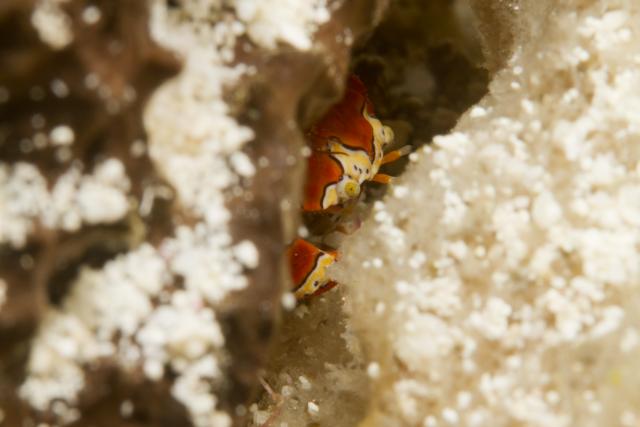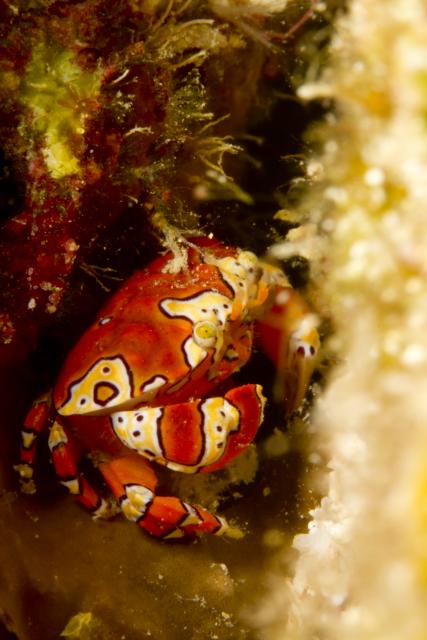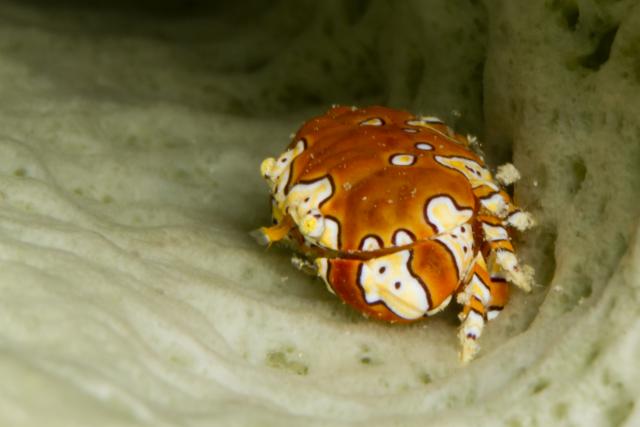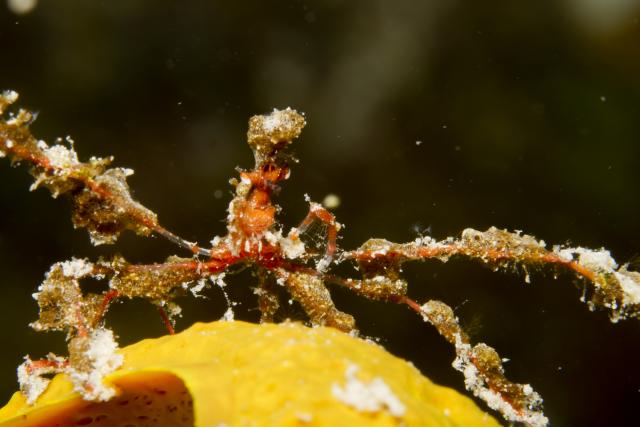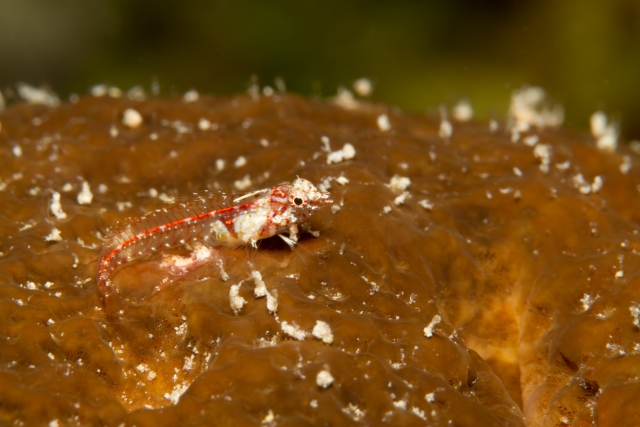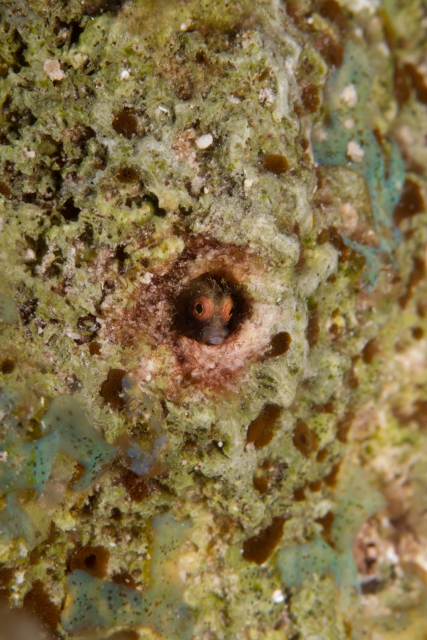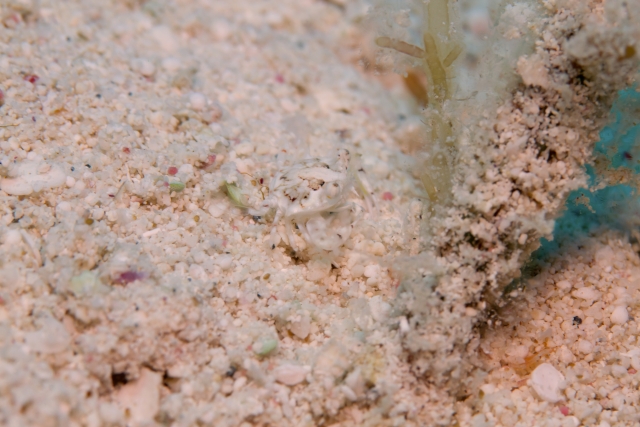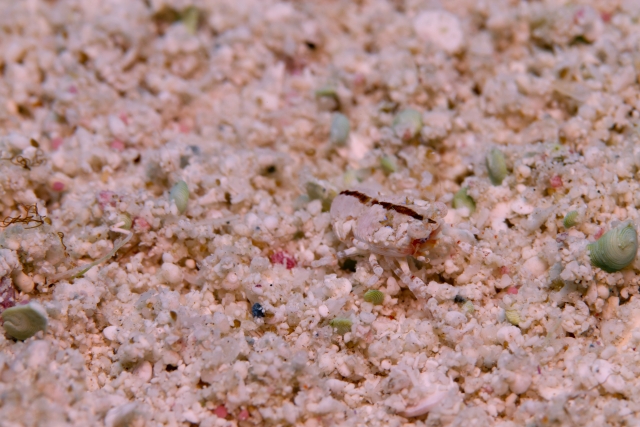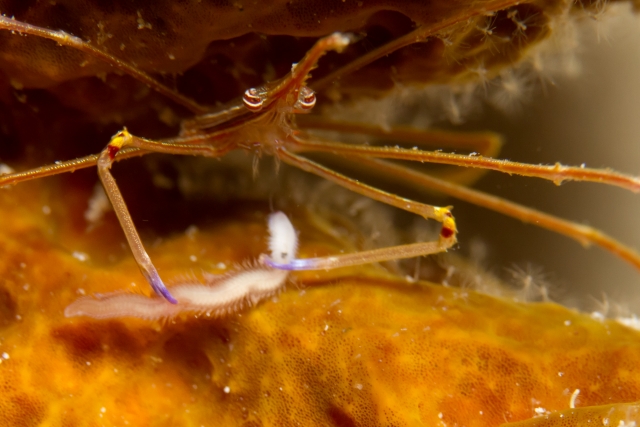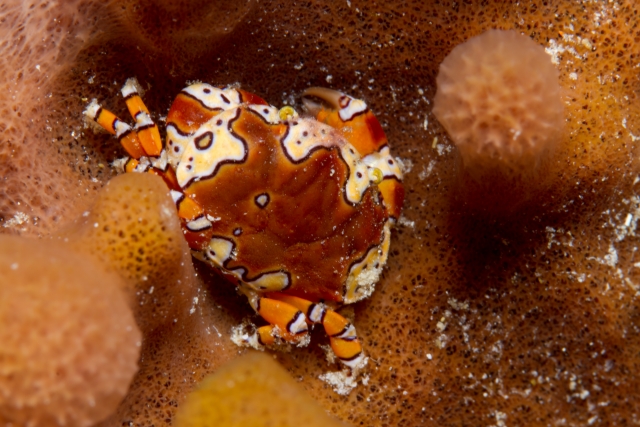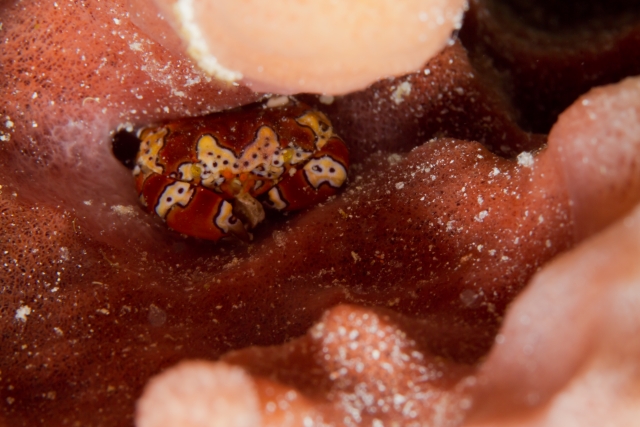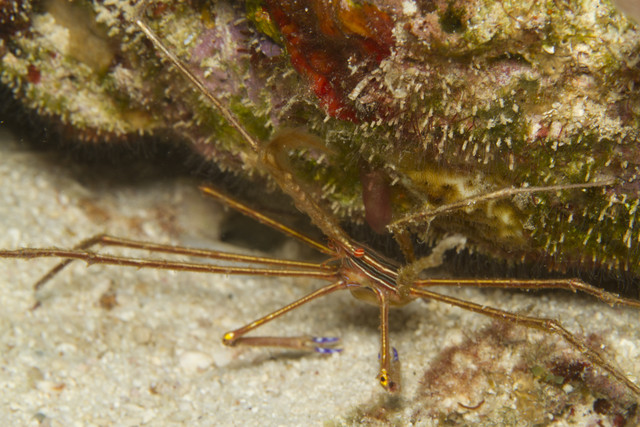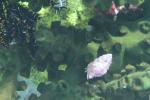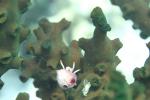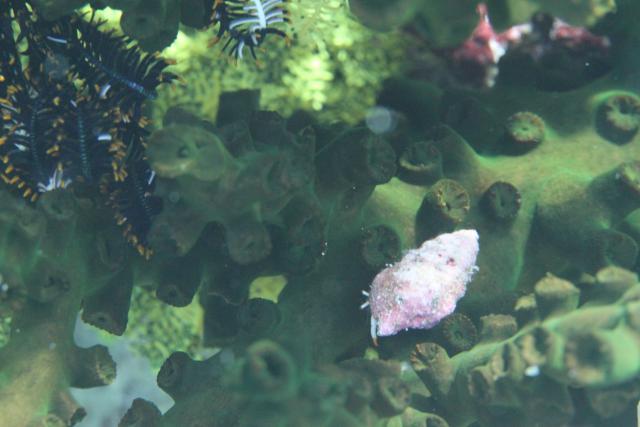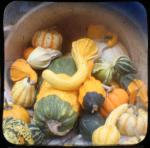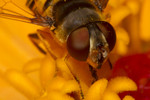crab
Turks and Caicos Explorer 2015: Guady Clown Crab
ktuli — Tue, 12/22/2015 - 19:29
So back in 2012 when we were first on the Turks and Caicos Explorer II, we were lucky enough to find a Gaudy Clown Crab (Platypodiella spectabilis). In fact, on that trip we did another dive at the same site to try and find it again for the boat captain.
Then last year on our trip to the Bahamas, we saw one but with my wide-angle lens, I wasn't able to get a good photo of it.
Fast forward some more to this year, and on our second day of diving, Anya spotted yet another one. Unfortunately, that one was tucked in a hole and I barely could get a photo of it. I took one (and actually kept it) just to show how difficult they were to photograph. I was going to share it here, but figured why waste the space.
On our very last dive, Anya found one that was actually sitting out on top of a sponge. Unfortunately, as I approached with the camera, it ran for cover....
I thought to myself that I blew it and I ruined an opportunity for a great photo subject... I took what photos I could, but really it was a lost cause.
Reluctantly, we swam off in search of other subjects.
On our return the boat, Anya spotted the same sponge, and noticed that the crab was in a better position again.
Thankfully, the little guy was probably the boldest Gaudy Clown Crab and decided to ignore me and proceed with his meal, moving along the sponge (though still somewhat concealed) eating. But he wasn't running for cover like they normally do...
Then... Anya found a second one on a different sponge!
This one was also pretty bold and at least didn't run away. I took a couple shots, but then found yet another cool subject inside the same sponge (and I'll share that tomorrow).
- Bill
Turks and Caicos Explorer 2015: Everybody Was Kung Fu Fighting!
ktuli — Mon, 12/07/2015 - 18:56
Ok - sorry, but every time I look at this photo, that's what pops into my head...
Technical Data: Canon EOS 7D, Canon EF 100mm f/2.8L Macro IS USM, 1/200th sec at f/20. Image Stabilization on. ISO 400. Ikelite Housing and Port and Ikelite 161 Strobe in TTL Mode. Raw conversion in Photoshop CS5.
This strange looking kung fu fighter is a Neck Crab (Podochela spp.) - a type of decorator crab, these odd little guys like to attach things like hydroids (example below), pieces of sponge, and whatever else they can find to their exoskeleton. There are theories that this is for camouflage, and some that the hydroids and any other stinging celled decorations are used to help with food collection. The second theory is supported by the fact that these guys often wave those long front legs out above them like this individual is here. Either way, it makes them definitely a cryptic and weird critter on the reef.
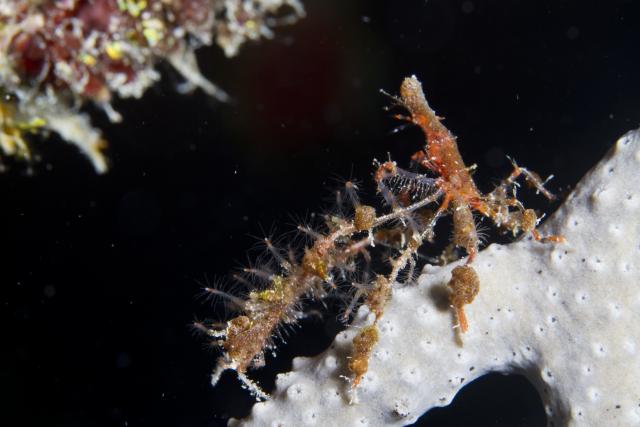 |
||
 |
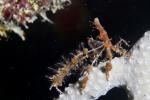 |
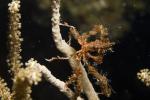 |
See what I mean - it is a challenge to even figure out what parts are what, but if you look closely, you will see a pair of eyes that stick out a bit to the sides of the head that sticks up like a post in the middle of the crab (kind of like an arrow crab). I find them fascinating!
- Bill
Aqua Cat: Critter Assortment
ktuli — Fri, 11/14/2014 - 23:02
Ok - so time for another assortment, and admittedly it is mostly crabs, but I'm saving some nudibranch shots for the next post, so stay tuned...
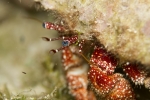 |
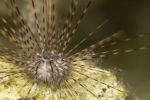 |
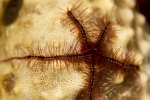 |
 |
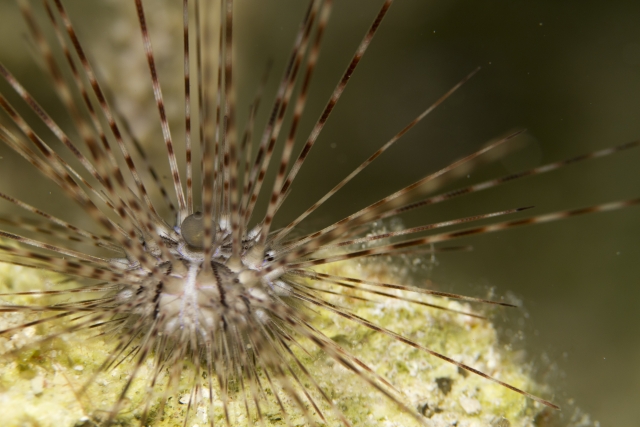 |
|||
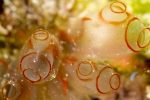 |
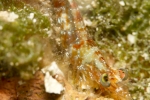 |
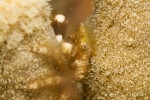 |
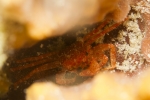 |
- Bill
Turks and Caicos Explorer: Find the Reef Critter
ktuli — Mon, 12/03/2012 - 20:25
So if you've been following along, you'll know that I love finding the little stuff. On land, it is one thing... and I'm constantly looking for bugs and spiders. On the reef, it takes on an entirely new challenge. Like the search for the Gaudy Clown Crab, finding interesting and beautiful tiny little creatures while on a dive is something I take great pride in doing.
Normally I would post cropped photos with their originals available with a mouse-over action. Instead, for these, I'm going to post the original and let you see if you can spot the tiny little critter. If you're having a hard time, simply mouse-over the image for a cropped view that should help...
We'll start off with something easy...
Technical Data: Canon EOS 7D, Canon EF 100mm f/2.8L Macro IS USM, 1/200th sec at f/16. Image Stabilization on. ISO 160. Ikelite Housing and Port with Ikelite 161 Strobe in TTL Mode. Raw conversion in Photoshop CS5.
Too easy? Ok - well, think about it this way. That shot was taken at 1:1.5 magnification. That means the frame is 1.3 inches x 0.9 inches. Looking at how much of the frame that Roughhead Triplefin (Enneanectes boehlkei) takes up, I'd estimate that it was only a mere 0.75 inches long. Sure - he stands out while sitting on top of that sponge, but still... that is a translucent bodied fish with some white markings (that mimic the white detritus stuck to the sponge) in a vast ocean.
Ok - this next one should be fairly easy too...
Technical Data: Canon EOS 7D, Canon EF 100mm f/2.8L Macro IS USM, 1/200th sec at f/16. Image Stabilization on. ISO 160. Ikelite Housing and Port with Ikelite 161 Strobe in TTL Mode. Raw conversion in Photoshop CS5.
That shot is also at 1:1.5 magnification, which makes that little guy about 0.15 inches high if my math is right. It is either a Roughhead (note the fringes above its eyes in the zoomed version) Blenny (Acanthemblemaria aspera) or a Secretary Blenny (Acanthemblemaria maria) - I can't tell which without more visibility to the markings on the side of the fish. I posted another blenny from last year's trip as well for more examples of these tiny little fish.
Alright, that's enough of the easy ones. Now we'll take a look at where camouflage and tiny size come together to make for an truly difficult find...
Technical Data: Canon EOS 7D, Canon EF 100mm f/2.8L Macro IS USM, 1/160th sec at f/11. Image Stabilization on. ISO 160. Ikelite Housing and Port with Ikelite 161 Strobe in TTL Mode. Raw conversion in Photoshop CS5.
That little guy is some sort of crab. I'm not able to find it in any of the identification books I have (not really surprising). Who knows - it could be a baby of some larger species of crab, or it could be that small all the time. Perhaps I found something no one else has ever seen before. All I know it is was tiny - probably in the range of 1/5th of an inch - and blended in perfectly with the sand.
Technical Data: Canon EOS 7D, Canon EF 100mm f/2.8L Macro IS USM, 1/200th sec at f/11. Image Stabilization on. ISO 160. Ikelite Housing and Port with Ikelite 161 Strobe in TTL Mode. Raw conversion in Photoshop CS5.
That ridiculously tiny and cryptic thing appears to be some sort of shrimp or maybe even a lobster larvae. Once you see it, that dark stripe really stands out, but considering this was spotted just out on the sand, it really wasn't easy to spot.
Having said all that, don't ask how I spot these things - the answer is "I just do". I can't explain it, I can't tell you what specifically I look for - I just scan constantly and things jump out at me. A line that breaks a pattern (eyes are usually a dead giveaway), or a pattern itself in some camouflage, or a tiny bit of movement - regardless of what it is, my eyes are constantly searching when I'm on a dive. Searching for the next awesome little critter to zoom in on and reveal a view on something most people don't get to see.
When's my next dive trip scheduled???
- Bill
Turks and Caicos Explorer: Arrow Crab Dinner
ktuli — Tue, 11/20/2012 - 19:40
Ok - a few posts ago, I mentioned that I would share a photo of an arrow crab that caught a blood worm just as I was taking photos of it.
The blood worms are harmless worms that swim in the water. Usually they are less than an inch long, though we did see some that were several feet long. During night dives, they are attracted to the lights, and honestly can get downright annoying. When you get too many in front of your dive lights, there are a couple things you can do. First, you can just turn off your dive light and they'll disperse - if a friend is nearby, they'll all swarm to their light while you swim away laughing. Second, you can feed them to brain corals... simply move your light close to a brain coral and the blood worms haplessly swim into the coral and are trapped and eaten. Or, if you're really lucky, you can feed other reef critters...
Technical Data: Canon EOS 7D, Canon EF 100mm f/2.8L Macro IS USM, 1/120th sec at f/8. Image Stabilization on. ISO 640. Ikelite Housing and Port with dual Ikelite 161 Strobes in TTL Mode. Raw conversion and cropped in Photoshop CS5. (mouseover for original uncropped version).
I seem to have taken a break from processing photos. I have seven dives left to process, so hopefully with the added time off from the holiday, I can possible get through the rest of them and get on a more regular posting schedule.
Stay tuned.
- Bill
Turks and Caicos Explorer: Gaudy Clown Crab
ktuli — Sun, 10/28/2012 - 20:06
I normally don't like to do this when processing photos, but I've decided to bounce around and pick and choose the order I process the photos from our last dive trip. One reason for this is that I was really struggling early in the week (more on that later), and so to get to the better photos, I have to jump ahead.
Another reason is that I am much more excited to share some of the subjects later in the week. Today's subject is just that.
This is a Gaudy Clown Crab (Platypodiella spectabilis). According to my ID book, these are listed as "occasional", but this is the first one I have ever seen, and when the captain of our boat asked me if I could find it again because he had never managed to get a good photo of one before (not sure if he'd seen one before or not), I felt really pleased with myself for having found it. Keep in mind, they only get to a maximum of 3/4 inch in size...
Technical Data: Canon EOS 7D, Canon EF 100mm f/2.8L Macro IS USM, 1/120th sec at f/16. Image Stabilization on. ISO 100. Ikelite Housing and Port with Ikelite 161 Strobe in TTL Mode. Raw conversion in Photoshop CS5.
So while I felt finding one of these crabs was an accomplishment, I took the challenge to find another on the following dive. I spent the entire dive searching barrel sponge after barrel sponge. And while I'm not 100% sure if this is the same crab or second one (I've tried matching the patterns, and can't come to a decision on it), I am very impressed that I was able to locate one of these crabs for the captain. Unfortunately, as you can see - it wasn't in as good of a location to photograph, so he'll likely have to keep looking... :(
Technical Data: Canon EOS 7D, Canon EF 100mm f/2.8L Macro IS USM, 1/120th sec at f/16. Image Stabilization on. ISO 100. Ikelite Housing and Port with Ikelite 161 Strobe in TTL Mode. Raw conversion in Photoshop CS5.
This is why I love diving... finding these beautiful little creatures that most people have never seen before.... and then doing it again.
- Bill
Caribbean Explorer: Hermit Crab Assortment
ktuli — Wed, 10/26/2011 - 19:44
Title pretty much says it all... these guys are pretty hard to identify, and I think some of them aren't even in the book. Most of them appear to be Red Reef Hermits (Paguristes cadenati), but the other three I can't tell for sure.
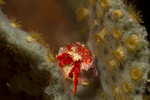 |
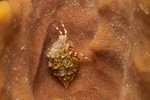 |
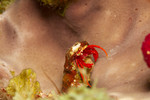 |
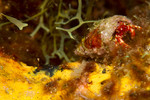 |
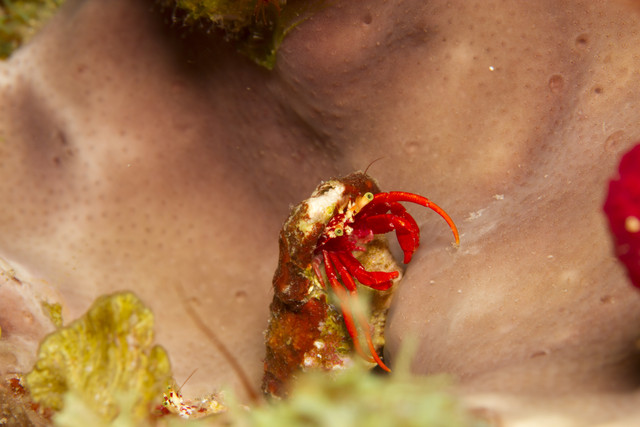
|
|||
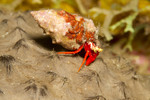 |
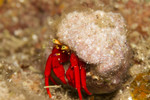 |
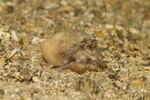 |
Technical Data: Canon EOS 7D, Canon EF 100mm f/2.8L Macro IS USM, 1/120th sec at f/16. Image Stabilization on. ISO 100. Ikelite Housing and Port with Ikelite 161 Strobe in TTL Mode. Raw conversion in Photoshop CS5.
Enjoy!
- Bill
Caribbean Explorer: Yellow-Lined Arrow Crab
ktuli — Wed, 10/12/2011 - 07:16
Well, I'm back! I have a bunch of photos still to process (not nearly as many as the Wakatobi trip because I decided going in that I was going to not use burst mode). Turns out, I came home with 821 photos, and the first round of culling brought me down to 602, so a much higher rate of keepers than before. I can't really spend much time on this post, so I'll just get to the photo...
Technical Data: Canon EOS 7D, Canon EF 100mm f/2.8L Macro IS USM, 1/120th sec at f/16. Image Stabilization on. ISO 100. Ikelite Housing and Port with Ikelite 161 Strobe in TTL Mode. Raw conversion in Photoshop CS5.
Today's subject is a Yellow-Lined Arrow Crab (Stenorhynchus seticornis). They are a fairly common resident of the reef, but I really love the patterns and colors they possess - those beautiful lines, and the strange red eyes, and even those odd bluish claws.
Stay tuned as I have some really awesome photos coming!
- Bill
Wakatobi: Hermit Crabs in Pink Shells
ktuli — Mon, 09/05/2011 - 13:31
I really can't wait till my upcoming dive trip, so I've been going back through some of my old shots trying to figure out what I could have done better. In particular, the one major problem with both of these images is the perspective. The top down view is not simply not very appealing. In this case, it was necessitated by the subjects' positions within the coral.
Oddly enough, these shots were taken on different dives, but they appear to be on the same species of coral. Further, the hermit crabs may even be the same species (notice the white legs with orange tips). However, the top down view makes identification almost impossible.
Technical Data: Canon EOS 7D, Canon EF 100mm f/2.8L Macro IS USM, 1/60th & 1/25th sec respectively at f/11.3. Image Stabilization on. ISO 3200 & 400 (Auto). Ikelite Housing and Port with Ikelite DS161 Strobe in TTL Mode. No post production.
I'm sure I'll still use this technique when absolutely necessary, but will also try to make sure I get different angles of subjects when possible.
- Bill
Wakatobi: Spotted Porcelain Crab
ktuli — Sun, 08/14/2011 - 21:14
I really need to get back in the water... soon.
Technical Data: Canon EOS 7D, Canon EF 100mm f/2.8L Macro IS USM, 1/25th sec at f/8. Image Stabilization on. ISO 400 (Auto). Ikelite Housing and Port with Ikelite 161 Strobe in TTL Mode. Auto-smartfix, Brightness -15, Contrast +10 in Adobe Photoshop Elements 8 (mouseover for original).
Why This Photo: I like porcelain crabs - they are cool little crabs... We only saw a few on the trip, and even though this isn't a perfect shot, I still like it.
What Works: While the original was a bit off with the crab up in the upper right corner facing out of the frame, the crop brings the face of the crab down to the bottom left corner and has it facing into the frame. The original exposure is a tiny bit bright, so I toned things down a little in PP.
What Doesn't Work: The focus is pretty good, but the shutter speed of 1/25th of a second produced a bit of blur because of the movement of the crab's feeding "claws". Also, unfortunately, the crab was resting on a drab anemone - which worked great for camouflage, but is kind of boring as a photo.
Like I said, I like porcelain crabs. This species - Neopetrolisthes maculatus - is a small crab (about 1.25" max) that lives in anemones. They feed with modified claws that they fan out to catch small particles out of the water. They do have larger claws that they mainly use for defending themselves and their host anemone.
I'd really like to reacquaint myself with one sometime soon... if I do, I'll bring you more photos, and hopefully improve on my mistakes made in this one.
- Bill

